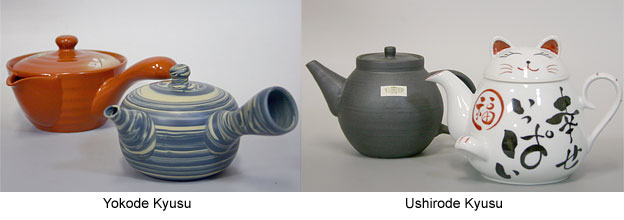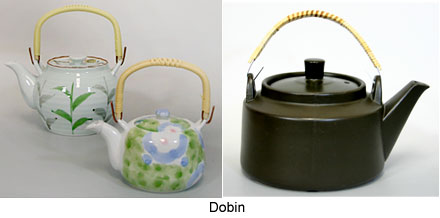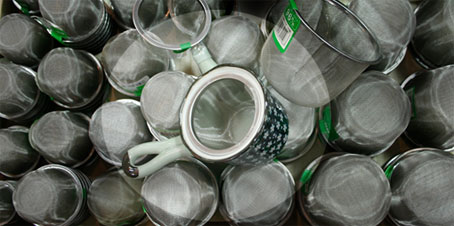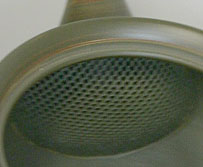Types of teapot
Teapots of every kind are made all over Japan. Specialized pottery shops sell all shapes and sizes, some made of clay, some of porcelain, some earthenware rustic styles, others whimsical with a comic touch. The varieties are endless and one could spend countless enjoyable hours in the quest to find the ideal one. Some tea lovers are said to favor certain styles for certain types of tea, but it really is up to the individual to decide on his or her own preference. Shown here are some examples of the most common varieties:

Yokode Kyusu are teapots with the handles placed on the side of the pot. The design of these pots makes it easy to pour out every last single drop of tea. Teapots made especially for left handed people also exist although designs are limited.
Ushirode Kyusu have the handle at the back of the pot, just like teapots in other parts of the world. These pots are easy to use whether one is right or left handed and are particularly suited to those who are used to using western style teapots. (The teapots in the above photo are from Tokoname, Japan, apart from the lucky cat teapot which is from Hasami, Nagasaki pref.)

Dobin is the name originally given to pots made of heat-resistant material used as kettles for boiling water and also to brew medicinal herbs. Nowadays the name refers to pots of a similar design to the original. These are made of porcelain or clay and used in the same way as normal teapots. The handle, usually made from bamboo, rattan or plastic is attached to the pots with hooks and has the advantage of staying cool despite the heat in the pot. (The dark brown dobin is Banko yaki from Yokkaichi, Mie-pref. and the other two porcelain dobins are from Hasami, Nagasaki-pref.)
Teapot strainers
Teapot strainers
Apart from different kind of teapots, we can also find a wide selection of strainers.

Stainless steel strainers
These strainers come in two types, removable and unremovable. The unremovable types share the same advantages of their in-built counterparts below with the added merit that the mesh is finer and more durable. They come in many designs. The main advantage of the removable type of stainless steel strainer is that they can be washed. Basket type removable stainers can be bought separately in 2mm pitch sizes. Finding the exact size for the pot is easy, and old strainers which have become stained or deformed can be replaced quickly and cheaply, making these types a popular choice for everyday use. However some tea connoisseurs feel that the stainless steel mesh affects the taste of the tea and this is why they recommend built-in ceramic strainers, such as those found in high quality teapots (see below) when brewing particularly fine teas.

In-built strainers

These are made of the same material as the pot and attached during the manufacturing process. Having the strainer attached to the spout means that there is more space in the pot to enable the tea-leaves to “jump”. The size of the holes in the strainer varies according to the age of the pot and the fashion of the time. For example, in the 1940's the dominant trend was for strainers with fairly large perforations. As finer, powdery tea became popular in the 1970's the perforations became markedly smaller, only to return to their original larger size, when larger leaves again became popular at the beginning of this century.
On our home page we have selected what we believe to be especially fine examples of Japanese teapots, mostly with in-built strainers which are available for shipping worldwide. We also have a wide selection of other types of teapots in our actual store so please do not hesitate to contact us if you are looking for a particular type or need any additional information.